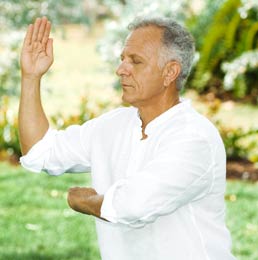
Tai chi (“tie chee”) looks so gentle, but it packs a powerful punch. The ancient Chinese system of exercise combines slow, flowing, dance-like movements with mental focus and deep breathing. Fans of tai chi say it’s great for fitness, relaxation and concentration. Now two well-designed studies (Arthritis Care and Research, April 15, 2007; Clinical Rehabilitation, February 2007) show that it also might help improve joint symptoms in people with knee or hip osteoarthritis.
One small study by researchers at Texas Tech University included 41 older adults with osteoarthritis of the knee. These older adults were randomly divided into two groups. One group took part in tai chi classes for six weeks, followed by another six weeks of practice at home. The other group attended health lectures instead. At study’s end, those in the tai chi group, but not the lecture group, had slightly decreased joint pain. In addition, the tai chi group had somewhat better improved physical function compared to the lecture group.
A second study by Australian researchers also found encouraging results. This study included 152 older adults with osteoarthritis of the knee or hip. The participants were randomly divided into three groups: tai chi classes, water exercise classes or a waiting list. After 12 weeks, those in both the tai chi and water exercise groups reported moderate improvements in physical function, although only water exercise led to slightly decreased pain. The benefits were still evident three months after the classes ended.
Tai chi originated as a martial art in China around the 12th century AD. Over time, people began using it for health purposes as well. Tai chi is designed to balance life energy, known as qi (“chee”) in traditional Chinese medicine. By restoring this balance, it’s thought to help the body heal itself and return to a normal, healthy state.
Whether or not you buy into this explanation, it’s clear that tai chi is a good way to stay active. And physical activity, in turn, promotes overall health. Among other benefits, tai chi may help improve balance, flexibility and muscle strength.
Many people do tai chi to enhance their health and feel better. Because it’s such a gentle form of exercise, tai chi seems especially well suited to those with arthritis. Research suggests that it may help reduce joint pain, stiffness and disability for people with osteoarthritis.
Tai chi requires strict attention to body posture and breathing, so it’s best learned from an instructor rather than a book or video. Some Arthritis Foundation® chapters offer tai chi classes that are specially designed for people with arthritis and don’t require deep bending or squatting. If such classes aren’t available in your area, tai chi also is taught at many recreational centers, health clubs and private studios. There is no standard credentialing for instructors, so always ask about a prospective teacher’s training and experience. If you decide to sign up for a class, be sure to tell your instructor about your osteoarthritis. Also, ask your doctor whether you might need to modify any moves.
PLEASE NOTE: The studies and their findings that are presented in this article are for informational purposes only and are not meant to take the place of the advice of your doctor. By providing you with this information, Sanofi is not endorsing its content nor does it represent that the information is necessarily appropriate for you. You should consult with your doctor before starting any new health or exercise regimen.
Arthritis Foundation is a registered trademark of the Arthritis Foundation®.
References“Tai chi.” National Center for Complementary and Alternative Medicine. Available at: http://nccam.nih.gov/health/taichi. Accessed September 6, 2011.
“Group and Home-Based Tai Chi in Elderly Subjects With Knee Osteoarthritis: A Randomized Controlled Trial.” J.M. Brismée et al. Clinical Rehabilitation. February 2007, vol. 21, no. 2, pp. 99-111.
“Physical Activity for Osteoarthritis Management: A Randomized Controlled Clinical Trial Evaluating Hydrotherapy or Tai Chi Classes.” M. Fransen et al. Arthritis Care and Research. April 15, 2007, vol. 57, no. 3, pp. 407-414.
“Alternative Treatments for Arthritis: An A to Z Guide.” D. Foltz-Gray. Atlanta, GA: Arthritis Foundation, 2005, pp. 226-227.
“The Effect of Tai Chi on Health Outcomes in Patients With Chronic Conditions: A Systematic Review.” C. Wang et al. Archives of Internal Medicine. March 8, 2004, vol. 164, no. 5, pp. 493-501.
“Improvement in Balance, Strength, and Flexibility After 12 Weeks of Tai Chi Exercise in Ethnic Chinese Adults With Cardiovascular Disease Risk Factors.” R.E. Taylor-Piliae et al. Alternative Therapies in Health and Medicine. March/April 2006, vol. 12, no. 2, pp. 50-58.
“Tai chi: Discover the many possible health benefits.” Mayo Clinic. Available at: http://www.mayoclinic.com/health/tai-chi/SA000877. Accessed September 6, 2011.
“Arthritis Foundation Tai Chi Program.” Arthritis Foundation. Available at: http://www.arthritis.org/events/getinvolved/ProgramsServices/taichi.asp. Accessed September 6, 2011.